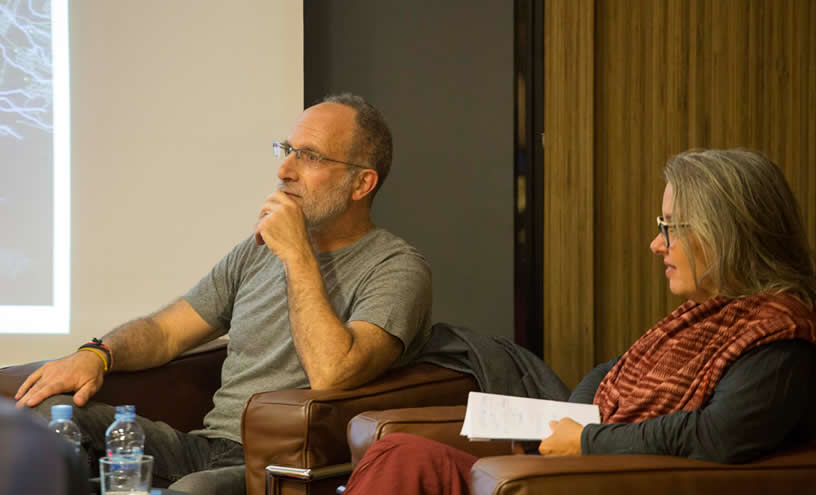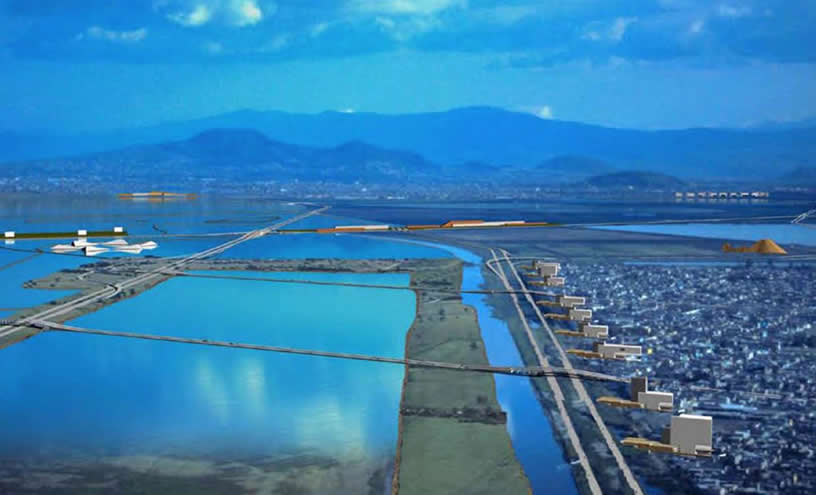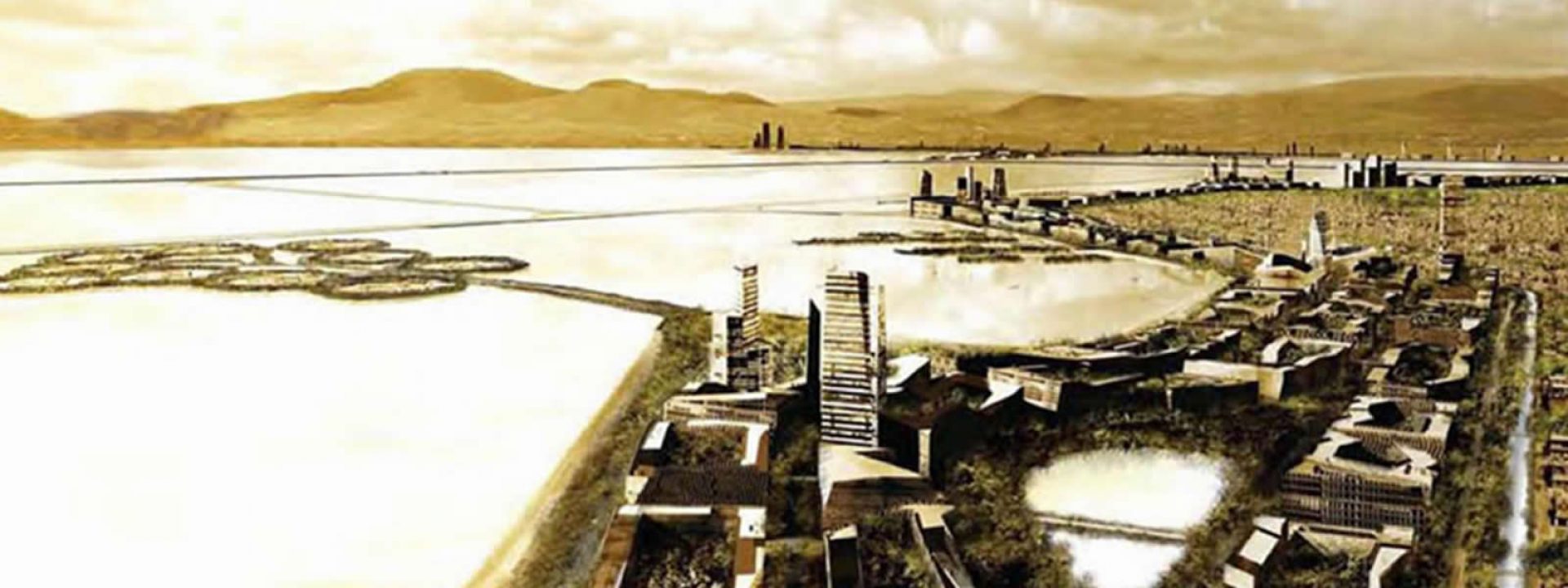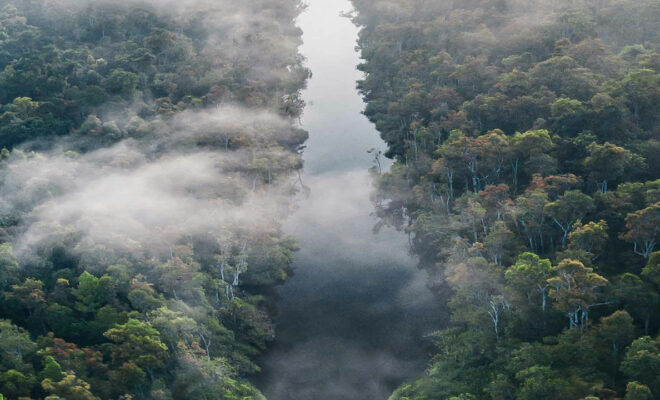
Alberto Kalach and Zaida Muxí
“Mexico City is the perfect example of what a city should never become“. The Mexican architect Alberto Kalach started his presentation firmly at the packed auditorium of the Roca Barcelona Gallery. This was the first conference of the series Water and metropolis organised by the We Are Water Foundation together with Casa Amèrica Catalunya. The architect and town planner Zaida Muxí, who presented the event, defined Kalach and his project as an example to be followed for the reencounter of the city with water, something that is urgent in our society: “Mexico City, as many other large cities, will need to face its relationship with water in order to survive”, the professor at the Escuela Técnica Superior de Arquitectura de Barcelona (School of Architecture of Barcelona) declared.
Kalach started with a short and entertaining account of the history of the large city, from Mexico-Tenochtitlan in the fifteenth century to the current federal capital. It is a story with a clear loser: water.
Before the arrival of the Spanish conquerors, Mexico-Tenochtitlan was a magnificent city, located in a valley surrounded by five lakes. This location, at 2,200 m above sea level and its tropical latitude (19ºN), provided the perfect climatic features for its 500,000 inhabitants to live at the shores of the lakes surrounded by forests in an environment in harmony with nature. “The colonists destroyed the water balance and were not able to recover it afterwards. The water from the lakes started evaporating and becoming salty, and the aquatic mass started disappearing”, Kalach declared, illustrating this process with enlightening images that sadly remind us of the ones seen at the Aral Sea or the Urmia Lake; a blue spot that decreases, leaving behind barren and eroded soil.
The coup de grâce for the Mexican lakes arrived with the demographic explosion in the last five decades, in which Mexico City increased its population from 3 to 18 million inhabitants, also increasing the urban soil from 230 km2 to1,550 km2, with shanty towns in 75% of this surface. “The lakes have been replaced by areas full of litter, parched earth and shanty towns whose inhabitants do not have running water or sanitation. The urban fabric has become a cancer for the earth crust over there”, the architect declared.
But Kalach sees this as a useful and educational example of what should never happen and also of the opportunities that always arise to recover the environment no matter how damaged it is. He proves it with his project Mexico: Return to the lakeside city, which for the architect is not a utopia but a tangible action of what can still be recovered: “The management of water is related to social organisation. Mexico City is not organised socially and the project tries to lead urban development in that direction, and there is a lot to do, for instance, in a city where only 10% of the used water is purified, the rest flows polluted into the Gulf of Mexico. If the city recovers natural water we will take a very important step for all of us”.
The water problem in Mexico City is shared by most Latin American colonial cities that have grown in valley bottoms with an erroneous and generally ineffective urban planning. “Cities that grow on aquifers obstruct rain water with a barrier of asphalt and concrete -Kalach explained-. Groundwater starts decreasing until it disappears, creating two problems. Water flows on the pavement and accumulates causing flooding and, as the aquifers decrease the city literally sinks: the urban centre of Mexico City has sunk up to 7 metres in certain areas.”
The supply and sanitation problems are also endemic in these large cities with an uncontrolled growth. Kalach assured that “in Mexico City half of the drinking water is lost due to the poor condition of the distribution network. There is also a political administration problem that has led to the neglect of 50% of the social housing, without water or sanitation.”
The project Mexico: Return to the lakeside city is encouraging as it proves, according to its creator, that it is still possible to act and that the return of the lakes is essential to improve the quality of life of the large city: “The recovery of the lakes is still perfectly possible: the water bodies have nearly disappeared but the soil around them is free, it has still not been occupied. We may recreate those lakes by creating focal points for urban development. Interconnected lakes that absorb the excess water and are nourished by purified water. The evaporation of the lake´s water will create more temperate microclimates and will decrease pollution significantly. We have studied climate models that prove that the water body would cause the return of sea breezes, renovating the air and decreasing its pollution by 30%.”
The return of lake water would allow what Kallach thinks is essential: reforestation. “The recovery of the plant cover is essential for the return of the water balance. We need to reforest in and outside the cities.”
The project by Kalach wishes to continue the one to recover the Texcoco Lake, started by the Mexican engineers Nabor Carrillo and Gerardo Cruickshank in 1965, which has achieved the creation of a water body of 36 million cubic metres on a surface of one thousand hectares. Kalach started Mexico: Return to the lakeside city fourteen years ago together with the architect Teodoro González de León, and during this time the project has encountered all kinds of difficulties: “The politicians, immersed in the struggle between parties, do not show any enthusiasm for this project; society in general has not shown a great interest either. We also need to coordinate the recovery of the lakes with the construction of the new airport, something that is necessary as the old one is already obsolete.”
The architect thinks that these problems are also opportunities to learn, while considering education a key point for the social transformation required by the return of water: “Large cities have great social problems. In order to solve them we need education, without which it is impossible to be aware of the importance of water in life and of the importance of the return of the city to it”.
The essence of the hope conveyed by Mexico: Return to the lakeside city is that in the end nature always returns: “If we help water to return and if we build a balanced environment, flora and fauna will end up reappearing. Nature knows what it has to do.”
In order to find out more about the project, visit the website of Alberto Kalach

Recreation of the Project Mexico, Lakeside City





